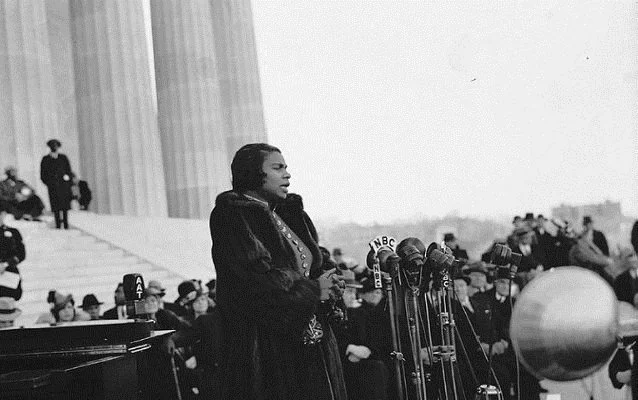An Anniversary of Great Influence
Marian Anderson’s impactful performance at the Lincoln Memorial (National Museum of American History, Robert Scurlock)
Beyond Granite: Pulling Together asks a somewhat deceptively simple question: What stories remain untold on the National Mall? It seems simple because there are so many answers. But those answers imply a follow-up question: How do we tell those stories?
When we talk about new models of commemoration, where does our imagination lead us? What do those models look like, feel like, and sound like? An extraordinary number of possibilities live within each of those questions.
As the curators of Beyond Granite’s pilot exhibition, Pulling Together, Dr. Paul Farber, Director and Founder of Monument Lab and Dr. Salamishah Tillet, Pulitzer Prize Winner and Professor of Africana Studies at Rutgers, understood that one of the project’s first—and most important—tasks was to find a way to give shape to this enormous landscape of possibility. They found the perfect historical reference point in the indomitable Marian Anderson who endured racial injustice when she was prevented from singing at Washington, DC’s Constitution Hall. In response, Anderson took to the steps of the Lincoln Memorial on Easter Sunday, 1939 to share her gifts with the world. Seventy-five thousand supporters, including First Lady Eleanor Roosevelt, attended the performance to show their solidarity.
Now, 84 years later, Marian Anderson’s courageous act of artistic purpose is remembered as one of the most impactful events to ever happen on the National Mall.
On the anniversary of that performance, Drs. Farber and Tillet reflect on how Marian Anderson is influencing Pulling Together, the pilot exhibition of Beyond Granite.
Dr. Salamishah Tillet: Pulling Together comes from this really transformative, iconic experience in 1939 when the opera singer Marian Anderson performed in front of the Lincoln Memorial. You have this massive image as the backdrop here: Marian Anderson singing before 75,000 people. And one of the people in the audience was the great educator and civil rights activist Mary McLeod Bethune.
Dr. Salamishah Tillet and Dr. Paul Farber (AJ Mitchell Photography)
Dr. Paul Farber: [As Bethune] said of the performance, "It told a story of hope for tomorrow, a story of triumph, a story of pulling together, a story of splendor, and real democracy". Whether it is Marian Anderson's performance, the history of protest gatherings from the Civil Rights movement to AIDS activism and beyond, the National Mall is a profound point of reference for what is at stake in our democracy. Here, on the Mall, we can understand how history lives with us. Through Beyond Granite: Pulling Together, we want to see the kinds of prototype monuments that summon both deep reflection and visions for transformation.
We think of the National Mall as this hallowed ground, and also a place where we can take on some of the biggest challenges and aspire to our greatest imagination for democracy.
Dr. Tillet: Democracy is not something that's static, nor is it something guaranteed. We see proof of this in Marian Anderson’s performance and Mary Mcleod Bethune’s response to it. In their story we see that through art we can shape democracy and inspire each other to push its limitations.
Pulling Together requires so much cooperation and conversation. This is what allows our democracy to grow, expand, and be preserved at this very complicated moment in our nation's history. We believe that Pulling Together is not just a series of prototype monuments, but also a kind of prototype for how we can engage democracy itself. With this inspiration in hand, Monument Lab will work with six visionary artists to engage these themes and explore creative answers to the question, “What stories remain untold on the National Mall”.


